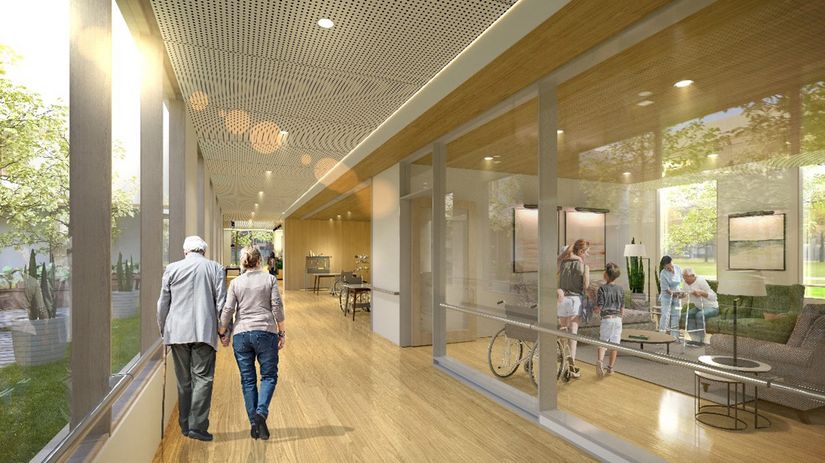Senior and alternative housing
About senior and alternative housing
The new senior and alternative housing is focused on the quality of the living environment. Care and services are adapted for the people, as well as their physical and mental health. Respect for their rights and freedoms, regardless of age, gender, sexual orientation, social situation, religion or origin, particularly for ethnocultural and First Nations or Inuit communities, are at the heart of this project. The objective is for them to feel at home.
Watch the video
Disclaimer: the video player is YouTube’s and may have some accessibility barriers. You can skip to the content after the video
Disclaimer: the video player is YouTube’s and may have some accessibility barriers. You can skip to the content before the video.
Live as you would at home
Senior and alternative homes are real living environments. They:
- are a warm place where care and services are organized based on the needs, preferences and pace of the residents and their loved ones;
- are made up of households with 12 rooms that each have their own bathroom with an adapted shower;
- present a residential aspect while fostering a close relationship between the residents, their loved ones and the staff;
- offer a family space that allows loved ones
- to organize special activities (gathering, party, etc.) and participate in them;
- benefit from an outside garden with easy access and balconies for each household on the upper floors;
- offer spaces with materials for entertainment alone or as a group, as the person wishes;
- has a medicine cabinet directly in the resident’s room.

Representation of a private unit of a senior and alternative home.
Presence of loved ones
Loved ones are welcome at all times, according to the resident’s wishes. The family and loved ones are invited to spend time together, for example, by having a meal alone together or staying overnight in the resident’s room.
Maintaining ties with caregivers is important in residents’ day-to-day lives. Their involvement can take various forms, such as:
- emotional support;
- collaboration with staff members to help with feeding;
- accompaniment during outside appointments.
Different means of technological communication are used to help maintain ties with children, grandchildren, friends, etc.

Representation of an inside common area of a senior and alternative home.
How it works
Senior and alternative homes are focused on the needs of each resident in:
- adapting the care and services to the resident’s needs;
- ensuring the resident’s free and informed consent based on the resident’s values and preferences, while ensuring the resident’s safety, quality of life and autonomy;
- respecting the resident’s pace, choices and preferences;
- putting the resident’s history and life plan at the heart of decisions;
- allowing residents to decorate and arrange their environment according to their preferences;
- ensuring their privacy;
- respecting their lifestyle, sleep and preferences regarding when to have meals or engage in leisure activities.
Active involvement of the resident
Caseworkers involve the residents and their loved ones in decisions about them at every life stage and invite them to participate in planning their care and services. It is important that the decisions made by the residents are respected, even if they carry some level of risk.
Depending on their abilities and wishes, residents can participate in various daily tasks and self-care (shaving one’s beard, washing one’s face, etc.).
Community participation
Senior and alternative homes are an integral part of their community. They are located in the heart of communities, thereby fostering connections and the feeling of belonging with them. Relationships between the residents, their loved ones, the caseworkers, the volunteers and various community players remain essential.
The home allows a partnership with community organizations, schools, recreational organizations that offers residents the opportunity to participate in activities offered by the community. The presence of volunteers and caregivers in the homes is encouraged, as is the contribution of residents to the different community activities.

Representation of an aerial view of a senior and alternative home.
Eligible persons
When staying at home is no longer possible, different housing opportunities are available. For access to housing, you can contact your region’s local community services centre (CLSC) or your caseworker if you already have one (patient navigator, home care worker or rehabilitation centre worker).
Senior homes are for elderly persons who have lost considerable autonomy. Alternative homes are for adults with a physical or intellectual disability or an autism spectrum disorder.
Cost
Any persons aged 18 or older whose health requires their admission to a residential and long-term care centre contribute to the payment of their accommodation and the costs of room and board.
The Régie de l’assurance maladie du Québec (RAMQ) manages the Financial Contribution Program for Accommodated Adults . It is mandated to determine the financial contribution of these persons in a manner that is consistent, fair and impartial across the network. This amount considers the resident’s financial situation. A maximum is also established.
Last update: May 3, 2023



